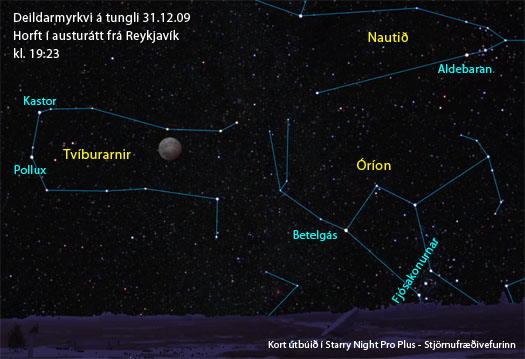31.12.2009 | 12:41
Blįtt tungl og deildarmyrkvi
Ķ gęrdag og -kvöldi var mįninn sjįlfur einstaklega fagur į himninum. Ķ kvöld er tungliš fullt, ķ annaš skipti ķ mįnušinum. Talaš er um blįtt tungl žegar tungliš er fullt ķ tvķgang ķ sama mįnuši. Ķ fyrra skiptiš var tungli fullt žann 2. desember. Blį tungl verša į um tveggja og hįlfs įrs fresti eša svo. Enn sjaldgęfara er aš blįtt tungl renni upp į gamlįrskvöld. Žaš ku gerast eini sinni į hverjum nķtjįn įrum eša svo.
En žaš er ekki ašeins blįtt tungl į gamlįrskvöld heldur fįum viš lķka aš njóta deildarmyrkva į tungli. Deildarmyrkvar verša žegar hluti tunglsins fer inn ķ alskugga jaršar. Ķ žetta sinn myrkvast nęstum 8% af sušurhveli tunglsins svo um er aš ręša minnihįttar deildarmyrkva. Myrkvinn veršur ķ hįmarki klukkan 19:23 aš ķslenskum tķma. Tungliš er žį į austurhimni ķ tvķburunum. Žś getur smellt hér til aš sjį góša hreyfimynd af deildarmyrkvanum.
En hversu oft ber deildarmyrkvaš blįtt tungl upp į gamlįrskvöldi. Samkvęmt SpaceWeather.com er svariš um žaš bil einu sinni į hverjum 91 įri. Žaš er sjįldgęft. Vonandi sést ķ heišan himinn ķ kvöld. Žaš er um aš gera aš fara śt eftir gamlįrsmatinn til aš njóta žess sem fyrir augum ber. Prófašu aš nota handsjónauka og ef žś ert svo heppin(n) aš eiga stjörnusjónauka er um aš beina honum aš tunglinu. Žaš er kjöriš aš kvešja įr stjörnufręšinnar meš žessum hętti.
Flokkur: Vķsindi og fręši | Breytt s.d. kl. 16:25 | Facebook



Athugasemdir
Las grein ķ sumar ķ kanadķska blašinu Sky News žar sem sagt er frį žvķ aš merking „once in a blue moon“ hafi lķklega veriš aš tungliš vęri blįtt vegna t.d. ösku sem į sveimi ķ gufuhvolfinu. Meira um žetta ķ öšrum pistli hér: http://www.skyandtelescope.com/observing/objects/moon/3304131.html?page=3&c=y
Sverrir Gušmundsson (IP-tala skrįš) 31.12.2009 kl. 12:57
Miskilningur aš blįtt tungl sé žegar tungliš er fullt ķ tvķgang ķ sama mįnuši:
YAHOO.COM:
Rare New Year's Eve 'blue moon' to ringin2010 By ALICIA CHANG, AP Science Writer Alicia Chang, Ap Science Writer – Tue Dec 29, 7:03 pm ET
LOS ANGELES – Once in a blue moon there is one on New Year's Eve. Revelers ringing in 2010 will be treated to a so-called blue moon. According to popular definition, a blue moon is the second full moon in a month. But don't expect it to be blue — the name has nothing to do with the color of our closest celestial neighbor.
A full moon occurred on Dec. 2. It will appear again on Thursday in time for the New Year's countdown.
"If you're in Times Square, you'll see the full moon right above you. It's going to be that brilliant," said Jack Horkheimer, director emeritus of the Miami Space Transit Planetarium and host of a weekly astronomy TV show.
The New Year's Eve blue moon will be visible in the United States, Canada, Europe, South America and Africa. For partygoers in Australia and Asia, the full moon does not show up until New Year's Day, making January a blue moon month for them.
However, the Eastern Hemisphere can celebrate with a partial lunar eclipse on New Year's Eve when part of the moon enters the Earth's shadow. The eclipse will not be visible in the Americas.
A full moon occurs every 29.5 days, and most years have 12. On average, an extra full moon in a month — a blue moon — occurs every 2.5 years. The last time there was a lunar double take was in May 2007. New Year's Eve blue moons are rarer, occurring every 19 years. The last time was in 1990; the next one won't come again until 2028.
Blue moons have no astronomical significance, said Greg Laughlin, an astronomer at the University of California, Santa Cruz.
"`Blue moon' is just a name in the same sense as a `hunter's moon' or a `harvest moon,'" Laughlin said in an e-mail.
The popular definition of blue moon came about after a writer for Sky & Telescope magazine in 1946 misinterpreted the Maine Farmer's Almanac and labeled a blue moon as the second full moon in a month. In fact, the almanac defined a blue moon as the third full moon in a season with four full moons, not the usual three.
Though Sky & Telescope corrected the error decades later, the definition caught on. For purists, however, this New Year's Eve full moon doesn't even qualify as a blue moon. It's just the first full moon of the winter season.
In a tongue-in-cheek essay posted on the magazine's Web site this week, senior contributing editor Kelly Beatty wrote: "If skies are clear when I'm out celebrating, I'll take a peek at that brilliant orb as it rises over the Boston skyline to see if it's an icy shade of blue. Or maybe I'll just howl."
Veit miklu betur en allir ašrir (IP-tala skrįš) 31.12.2009 kl. 14:48
Misskilningur.
Veit miklu betur en allir ašrir (IP-tala skrįš) 31.12.2009 kl. 14:50
Bęta viš athugasemd [Innskrįning]
Ekki er lengur hęgt aš skrifa athugasemdir viš fęrsluna, žar sem tķmamörk į athugasemdir eru lišin.